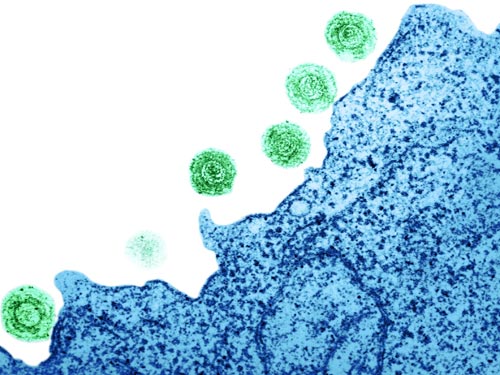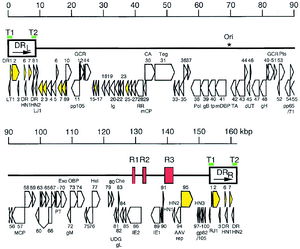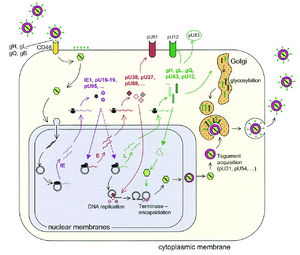Human Chromosomal Integration of Latent State Human Herpes Virus 6 (HHV-6): Difference between revisions
From MicrobeWiki, the student-edited microbiology resource
| Line 9: | Line 9: | ||
==HHV-6 Replication Cycle== | ==HHV-6 Replication Cycle== | ||
[[Image:HHV-6 Replication.jpeg|thumb|300px|right| [http://cmr.asm.org/cgi/content/full/18/1/217/F2 Figure 3.] Lytic replication cycle of HHV-6.]] | |||
==Epidemiology== | ==Epidemiology== | ||
Revision as of 19:34, 1 November 2010
By: Kerri-Lynn Conrad
Introduction

Figure 1. Transmission electron micrograph visualization of Human Herpes Virus-6 (HHV-6) on the surface of a human lymphocyte. HHV-6 is the causative agent of roseola, a disease that effects nearly every human infant.
Genomic Structure of HHV-6

Figure 2. Genomic organization of HHV-6B. The asterisk indicates the start of lytic genomic replication. Viral telomeric sequences are indicated by green bars T1 and T2. Open arrows represent protein coding regions.
HHV-6 Replication Cycle

Figure 3. Lytic replication cycle of HHV-6.
Epidemiology
Pathophysiology of HHV-6 Infection
Initial Infection
Latency in Healthy Children and Adults
Reactivation in Immunosuppressed Individuals
HHV-6 Associated Disease States
Latency through Human Chromosomal Integration
Transmission through Germ Line
Future Work
References
Edited by Kerri-Lynn Conrad, student of Joan Slonczewski for BIOL 375 Virology, 2010, Kenyon College.
